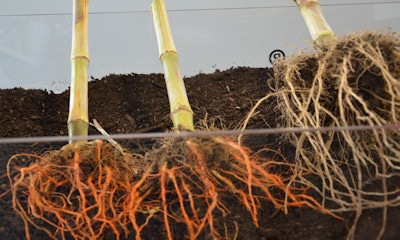
Melissa Bell may be a researcher, but she loves to be in the field, working with plants and farmers. Working in east-central Illinois and living across the state line in Indiana, she has worked with three farmers over the past couple of years to look at how various hybrids respond to changes in population. She has looked at how population affects root development, ears and yield. Bell is a commercial agronomist for Mycogen Seeds.
Her first conclusion had very little to do with hybrids and seeding rates. “First and foremost, weather has a huge impact on how hybrids respond and how they react to different populations,” she says.

WEATHER WINS: This display of roots grown at different populations in the Dow AgroSciences exhibit at the 2015 Farm Progress Show was impressive. However, the researcher who worked with these plants, Melissa Bell, says weather can trump population.
It may not seem like rocket science, but sometimes weather seems to get lost in the conversation about which populations are best or how much N to apply. Bell says she saw a huge difference in trends from 2014 to 2015. She expanded her work in 2015, but she had comparisons in 2014 as well.
Related: Looking ahead to 2016, adjust corn plant population
“We saw higher yields at higher populations on soils with higher organic matter in 2014,” Bell says. That is pretty much what you would expect to see.
“However, because of the excess water and ponding in 2015, the soils with the highest organic matter tended to be the lowest yielding fields,” she says. They also tended to be the lowest part of the topography, containing the wettest soils. They were the areas that also tended to pond the worst last season.
Despite the excessive rain in 2015, Bell carried out her work. She did root digs at various populations and compared root sizes and developments, and she did it for both hybrids. She says that so far, she sees changes in root development depending upon how thick the corn is planted. Corn plants in a low-population environment will root differently than if the same hybrid is planted in a thick environment.
It’s also possible to plant too thick, she concludes. Her highest population, 40,000 seeds per acre, was negatively affected last year. She also saw more lodging in those plots.
“The take-home message, however, is the impact of weather in any one season,” she insists. “Weather is a huge deal.”
About the Author(s)
You May Also Like




